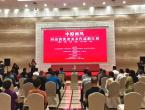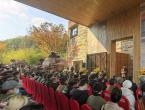Zhou Changgu's integration of Chinese and Western cultures
After graduating in 1962, I secluded myself in Ou Hai for 16 years, and had limited contact with Mr. Chang Gu. Upon returning to school in 1978, due to his persistent illness, our interactions were mostly focused on business and treatment matters. There were few opportunities for us to freely discuss and exchange ideas about painting, which is a pity as we lacked the understanding we deserved.
Mr. Chang Gu has a profound family background in art, deeply influenced by his father. He was intelligent and eager to learn from a young age, with a love for ancient poetry, calligraphy, and painting. He had a solid foundation in these arts during his teenage years. In 1948, he was admitted to the Hangzhou National Art School (now known as the China Academy of Art), where he received systematic and rigorous training in both Chinese and Western painting. In terms of traditional Chinese painting, he studied under masters such as Pan Tianshou, Huang Binhong, and Wu Changshuo, tracing his lineage back to Bada Shanren, Shi Tao, Xu Wei, and even Fang Congyi (known as Fang Hu), Gao Kegong (known as Fang Shan), Liang Kai, and the father-son duo of Mi Fu and Mi Shi. In Western painting, he studied under predecessors like Lin Fengmian, tracing his lineage back to Matisse, various Impressionist artists, and even classical masters such as Leonardo da Vinci, Raphael, and Modigliani. In his artistic practice, he insisted on prioritizing Chinese art and supplementing it with Western techniques. This approach allowed him to master the essence of traditional Chinese painting without falling into the trap of imitating the ancients or adhering to outdated styles. At the same time, he was open-minded and eclectic, extensively absorbing and integrating Western painting techniques and principles, laying a solid foundation for his unique artistic style.
Due to Mr. Changgu's adherence to the artistic path of "making the past serve the present" and "making foreign things serve China", which aligns with the requirements of the times and the laws of artistic development, he has achieved great success and become a master worthy of his reputation. Facts have proven that he is an outstanding painter who, since the founding of the People's Republic of China, has stood on the traditional foundation and absorbed foreign artistic explorations in the Chinese painting circle, where talents gather and stars shine brightly. People have gained considerable inspiration and encouragement from his art.
Chinese painting originated from figure painting. Landscape, flower, and bird paintings flourished during the Wei, Jin, Southern, and Northern Dynasties. From the Yuan and Ming dynasties onwards, figure painting tended to decline. After the founding of the People's Republic of China, the development of the times posed new demands on culture and art. As a superstructure, painting art was facing the new challenge of how to reflect the rapid social changes and the fiery real life. In the realm of figure painting, due to the significant changes in the subjects depicted and aesthetic sentiments, the ancient traditional techniques could no longer meet the new demands. Therefore, many young figure painters began bold attempts and arduous explorations. This was the historical background for some Zhejiang figure painters, later known as the "New Zhejiang School," to pursue artistic innovation. Among them, Mr. Zhou Changgu was a representative figure.
Due to Mr. Changgu's artistic path combining Chinese and Western elements, his outstanding talent, profound academic foundation, and superb technical skills, it is no coincidence that his maiden work "Two Lambs," created over 30 years ago, was the first to win the International Gold Medal after the founding of the People's Republic of China. This achievement made him renowned in the art world. Even with today's perspective, this painting can be regarded as a thought-provoking masterpiece in terms of its artistic conception, style, and technical skills, truly living up to its reputation. What is even more commendable is that he was not intoxicated by success or tainted by reputation. With a pure belief in the art industry, he continued to strive and diligently research despite facing adversity, making significant contributions to the artistic innovation of Chinese painting.
In the past, whenever traditional figure painting was mentioned, it was inevitably linked to the "Eighteen Drawing Techniques". However, it was ultimately difficult to express modern life satisfactorily. Therefore, based on the dialectical relationship between "form and content", Mr. Changgu conducted in-depth research on various expression techniques through continuous practice, and made a summary that combined practical experience with theoretical analysis. He integrated the "dotting and blotting method" from flower painting, combining the "lying brush" with traditional brush usage. Through diligent exploration, he mastered the technique of "using the lying brush to rotate", making the brushwork soft yet firm, more concise and vigorous. In terms of ink usage, based on the experience summary of Mr. Huang Binhong, a landscape painter who had in-depth research on ink techniques, and combined with his own practical experience, he made a detailed analysis of the seven ink techniques (thick ink, light ink, burnt ink, splashed ink, broken ink, accumulated ink, and aged ink), forming his own unique insights. For example, regarding the splashed ink technique, he believed that it involved pouring water mixed with ink or water mixed with color onto paper randomly, allowing it to flow freely, and then adding a few strokes to complete the painting. Or the paper could be blown into the inkstone, absorbing a lot of ink, resulting in a chaotic and colorful image, but with a long inscription claiming divine inspiration. None of these methods could be considered splashed ink painting. In brief, its artistic standard should be the natural charm that becomes better and better without intentional command (see the article "Using Ink and Water" in the November 1982 issue of "Art Series"). When it comes to the broken ink technique, he pointed out that there are two key points: it must be done when the ink is not dry, and the water should be used to make the ink (water color, color ink) permeate organically. On the contrary, the accumulated ink technique must be done after the ink is dry, layer by layer. The accumulated ink technique should focus on the word "falling", which represents the shortest contact time with the paper, rather than the real falling of the brush without touching the paper. For the aged ink technique, he pointed out that because the aged ink does not dissolve, it is even more stringent than the accumulated ink technique in terms of the requirement of not allowing "re-brushing". Therefore, it is not allowed to "drag", "smear", or "wipe", and the brushwork must be like a "dragonfly touching the water" falling on the paper.
How to improve the use of color in Chinese painting is a topic that Chinese painters are dedicated to studying. Mr. Changgu absorbed the principles of color tone processing in Western painting and successfully integrated it with the use of brush and ink, achieving a widely acclaimed artistic effect. Therefore, when one opens his scrolls, they are immediately struck by the dazzling brilliance and refreshing clarity. In the spring of 1982, Mr. Zhou held a solo art exhibition, where people were unanimously impressed by his grand and majestic artistic style, admired the vigorous brushwork and clear and moist ink charm in his works, and even more admired his elegant and bright colors. Mr. Zhou's use of color is capable of being heavy without being turbid, vivid without being vulgar, and powderless when applying powder, with the skill lying in the use of water. He pays great attention to the needs of the painting surface and the changes in ink color, cleverly utilizing the contrast and coordination of color tones to make the colors and ink charm complement each other. In my opinion, among Chinese painters, he is the most skillful and successful in the use of color techniques.
Mr. Zhou excels in portraying the delicate inner emotions of characters and the specific atmosphere of the environment. His paintings are imbued with a poetic conception and a rich lyrical tone, which are attributed to his solid foundation in modeling and ink application skills, as well as his high level of literary accomplishment. He often emphasizes to his students the importance of reading and pursuing knowledge for the art of painting. He himself has been diligently studying for decades, achieving remarkable results, which serves as an excellent example.
He is well aware of the unique comprehensive artistic characteristics of Chinese painting, and thus pursues and achieves a high level of artistic excellence that integrates poetry, calligraphy, painting, and seal engraving. This is commendable in today's Chinese painting circle, especially among figure painters. In calligraphy, Mr. Zhou first studied the styles of Wei steles, Mi Fu, and Huang Tingjian (known as Shangu Dao Ren), and later developed a fondness for cursive script. He combines the brushwork of Ba Da Shan Ren with modernist structures, allowing words to interlace and lines to echo each other. The entire piece is considered as a whole, exhibiting a sense of ease and freedom, as well as a majestic and unrestrained style, forming a new aesthetic. His talent is truly admirable. He is also proficient in seal engraving, where he can skillfully arrange and carve within a small space, creating a sense of interest and vitality. Many senior painters and calligraphers request his seal engraving, demonstrating his profound attainments. As he often says, he pursues the integration of calligraphy into painting to make it simple, vigorous, and profound, and also pursues the integration of painting into calligraphy to make it vivid and unique. This is a mutually beneficial approach.
He also absorbed many excellent traditions of "literati painting", such as the free and graceful use of brush, rigorous structure, bold use of ink, clear contrast, emphasis on the changes between void and solid in composition, the principle of "leaving white to appear as black", and dialectical correspondence. He emphasized the traditional typical exaggerated modeling techniques, combined with Western sketching (known as the "sketch king" in his early years), strengthened the memorization and freehand drawing of images, and employed the special creative method of "improvisation" in freehand Chinese painting, thus generating "opportunities" and seizing accidental chances to grasp the initiative and achieve advanced artistic effects according to circumstances. This is called "smoothness" and is constantly applied in practice. During our discussions on painting, Mr. Changgu often emphasized the importance of this traditional creative method, believing that its infinite expressiveness and advantages must be well inherited and carried forward.
Based on the study of the composition rules of "introduction, development, transition, and conclusion" in traditional two-dimensional space, he further developed and practiced "the combination of multiple lines and primary and secondary elements" as well as "continuous combinations", which have presented new challenges for the study of traditional painting techniques.
In summary, Mr. Changgu's erudition, self-cultivation, and artistic attainments are profound and extensive, necessitating a dedicated article for discussion.
On the foundation of becoming a representative figure of the "New Zhejiang School" in his early years, he embarked on higher-level academic research. Had it not been for the misfortunes and illnesses that led to his premature death, he could have achieved even greater accomplishments. As he painfully confided to me just over a month before his passing, he truly did not want to die, as he had many things to do, many plans and intentions he wanted to gradually realize, and a long journey he wanted to continue on
Copyright Notice: Original content on this website is welcome to be reposted. Please indicate the source when reposting, Global Art Network www.caanets.com; Some of the content posted on this website comes from the internet. If there is any infringement, please contact this website to delete it.




